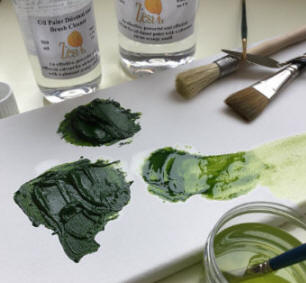 |
Techniques |
 |
Basic Traditional and Wet-on-Wet Oil Painting techniques explained.
There are many different ways to paint but the two most commonly used ones are, Traditional (indirect painting), a slow and controlled method. Wet-on-wet (direct painting) with this method, the painting is usually completed in one sitting, often referred to alla prima - at the first. The traditional method often uses a
tonal under-painting as the basis of the picture, usually grey (grisaille) or brown (bistre) in colour. This under-painting can be created with acrylic, gouache, ink or thin oil paint, depending on the finish and style of work. |
In the oil on canvas picture above, the drape of the sails was laid in as a grisaille. |
|
The
Fat
over Lean Principle Next layers of paint have less solvent. Next layers are tube paint - no solvent. Next layers are tube paint with a little oil. Final layer is tube paint with more oil added. |
When working in the traditional way it is important to work 'Fat over Lean'. 'Fat' is paint straight from the tube or with linseed oil added, this makes the paint more flexible when dry. 'Lean' is paint with no added oil or thinned with a solvent. The way it works is to start with paint that has low oil content (lean), followed by paint with high oil content, then paint with added
linseed oil (fat). |
|
With the wet-on-wet method, the painting is completed with, in effect, one layer of paint which is usually opaque or semi-opaque. The canvas is first wetted with a painting medium, either clear or coloured. The oil paint colours are then applied with a brush and/or a knife and a small amount of painting medium. Colours are applied and left 'as is' or blended using a brush or cloth to create the desired effect.
This method is ideal, especially when working outside, when the whole of the painting is completed in situ.
All the elements of the painting have to be mentally handled at the same time, with regard to tone, composition, shape, form and colour, etc. Because you are not waiting for paint to dry, which allows you thinking time, you need to know your materials and techniques well before you start. |
In the landscape painting above, the canvas was first covered with a very thin layer of
Zest-it Clear painting medium. |
 |
It's very easy to 'over mix' colours, this can lead to very flat, dead looking paint. Best avoided! ( 'Making Mud') Copyright© Jacqui Blackman 1999 |
Copyright 1999 - 2023 © J. & T. Blackman Ltd. All Rights Reserved Worldwide.
The information contained herein is the Intellectual Property of Jacqui Blackman and
J. & T. Blackman Ltd., and is supplied without liability for errors or omissions.
Zest-it ® and its logo are Registered Trademarks.
No part may be reproduced or used except as authorized by contract or other written permission, unless stated otherwise.
The copyright and the foregoing restriction on reproduction and use extend to all media in which the information may be embodied.![]()